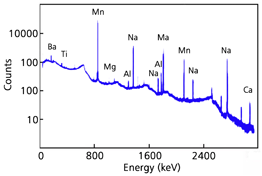- Neutron Activation Analysis -
Allows elemental characterization of samples by means of their interaction with neutron beams.
dating
morphology
technology
origin
composition
alteration

Ceramic

Glass

Mortar

Pigments

Stone
Ceramic Building Materials (CBM) & Glass
Frequently used for provenance studies of ceramic objects and glass, detecting particular chemical elements contained in trace quantities in the ceramic/glass matrix, which – after statistical processing and comparison with spectra of samples of known origin– can yield discriminating patterns or can indirectly indicate the raw materials’ sources (quarry, clay pit, etc.) and production chronology.
Mortar & Plaster
Elemental analysis* of mortar bulk samples is useful in order to classify them by identifying the nature of their binder and by detecting eventual mortar composition differences in their architectural stratigraphy.
Pigments
Pigment identification of stained glass, ceramic tiles, wall paintings, frescoes, etc. can be performed by means of NAA, where using other analytical techniques proves unsuccessful or provides insufficient data and detection limits*.
Stone
The elemental* composition of natural stone of unknown origin, based on the detection of trace elements or different element concentrations and compared with samples of known origin, can give an insight on its provenance and can help authenticate stone materials and/or identify previous substitutions in the building.

NAA spectrum
Neutron Activation Analysis (NAA) is a multi-elemental analytical technique, based on nuclear* processes, for both qualitative and quantitative analyses of almost any type of solid, liquid or gas material. Until the introduction of PIXE and ICP-AES NAA was the principal analytical method employed for achieving highly sensitive analyses below the part-per-million (ppm) detection limit range. Nowadays, NAA detection limits have reached the part-per-billion (ppb) level (Pollard & Heron, 2008). Produces a gamma ray spectrum with concentration ratios of the elements.
accuracy
time
cost
in situ
invasive
destructive
NAA is based on the interaction between an incident neutron beam and a non-radioactive sample and the examination of the characteristic decay patterns of the resulting radioactive products.
Neutrons generated by a nuclear reactor irradiate a sample, causing a fraction of the nuclei of the sample’s elements to transform into artificial radioactive elements, called radioisotopes. The nuclei of these radioisotopes, being in an excited state, are unstable and spontaneously decay in order to return to a more stable configuration (Glascock et al., 2004), releasing α, β particles or gamma-rays, which are collected by detectors. According to the radioactive decay patterns of the isotopes and the intensity of their gamma-ray emissions, the “parent nuclei” can be identified and their concentration in the sample can be measured.